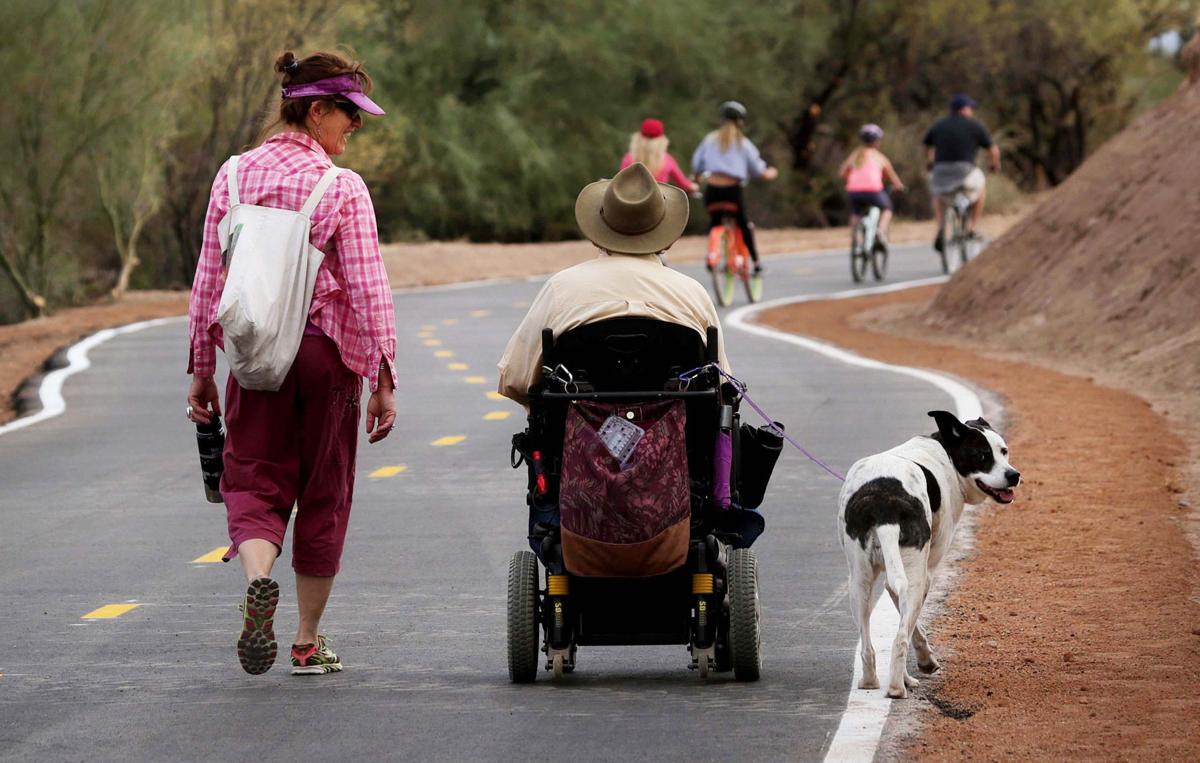Editor’s note: This is the first in a series that explores the Loop.
Technically, the Loop’s construction began in 1978. But it wasn’t called the Loop then.
If you’re unfamiliar, the Loop is a 131-mile trail that spans Tucson, South Tucson, Oro Valley and Marana. The Loop is used by bicyclists, walkers, joggers and equestrians. Cars aren’t permitted.
The Loop is so much more than a recreational biking and walking path. It originally started as river bank protection to control flooding near the Rillito River.
“At the time, we had just become the flood control district,” says Suzanne Shields, director of the Pima County Regional Flood Control District. “Most of the river was privately owned, so there were a lot of regulations.”
Eventually, after 150 acres of land were destroyed following a flood in 1983, the district was able to implement paved walkways and handrails near the Rillito to help team members maneuver during a flood. Shields says that prior to the paved walkways and handrails, it was nearly impossible to access the area.
At the same time, the district did a study of the Rillito area.
“One of the things that was evident in the study was a lack of recreational amenities in the area,” Shields says.
After the district added paved walkways and handrails for their own use, they noticed Tucsonans also using the bank protection, even though the walkway wasn’t very lengthy at the time.
“That’s when we put together the idea of creating a river park along the Rillito,” Shields says. “It all happened in baby steps.”
At the same time, Shields says Rio Nuevo was putting together a river park near the Santa Cruz River. The Loop now connects the Rillito and the Santa Cruz.
Soon after, more trails and landscaping were added to the Loop.
“About five or six years ago, there was a real push by the public to complete connections between the trails,” Shields says.
And in 2012, the Loop got its name.
“We started calling it the Loop six years ago,” Shields says. “At the time, people were using segments of the Loop that were near their house, but they had no idea they could keep doing more and going farther.
“We wanted a name for people to say, ‘Oh, that’s what it is!’”
Shields says public funding for the project had always been tight, but when they showed Tucsonans the many benefits of the Loop, including healthy lifestyles, recreational activities, environmental benefits, public safety and providing flood control, people got on board.
“When you look at it, it ticks off so many areas, so we received a lot of support from a lot of areas,” Shields says, adding that Tucson Medical Center was a huge supporter of the Loop because of its push for public health.
The biking community in Tucson is also very large, which inevitably worked in the Loop’s favor, she says.
“The general public has provided us with tremendous support,” Shields says. “When we went to the voters, they really wanted this and they approved it. People want public safety, but they also want something that they can use every day. It became an amenity that the public supported. And of course we do maintenance, but people really take care of the Loop. That’s pretty important — that the public accepts it to that level that they want to maintain it.”
Shields added that before the Loop project had reached the Pantano Wash, there was a flood in 2006 that caused erosion to the wash. She says events like that helped “spur people to provide bank protection because flooding is a big cost.”
Shields also says the Loop project gained a lot of support from the Pima County Board of Supervisors and County Administrator Chuck Huckelberry.
Shields says the Loop has also allowed for economic growth in Pima County.
For example, a number of groups, including Caterpillar, came to Tucson partially because of the Loop.
She also says Comcast was looking for a new office building, and when their realtor took them to an almost empty building on the southeast side of the Rillito, they noticed the Loop and said, “we’re taking this building.”
“It’s making an economic dent, which is something the community could use,” Shields says. “It draws a large grouping of people. To provide something that can be used by everyone is unique.”
The Loop was finally deemed complete in March of this year and connects many areas in Pima County. However, it’s not over yet. More projects are planned for the future.
“It took about 35 years to complete,” Shields says. “I think there was a lot more momentum toward the end because you could see the light at the end of the tunnel.”
Shields says that when the project initially began, she never thought it would become a 131-mile loop.
“I was hopeful that it would connect the Rillito to the Santa Cruz,” Shields says. “But it’s turned out to be so much more and so much bigger than I thought it would be. I’m really proud to be a part of it.”





